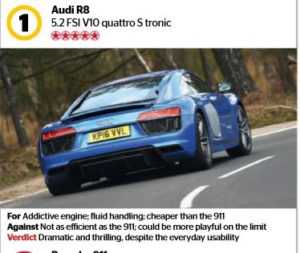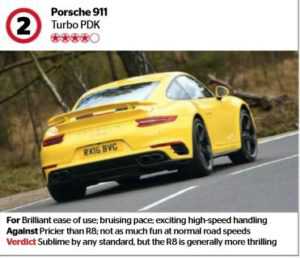Audi R8 vs. Porsche 911 Turbo
FOR DECADES THE Porsche 911 has been the benchmark to which other sports cars aspired. However, there are now markedly different 911 versions, and the four-wheel-drive powerhouse that is the 911 Turbo could be worthy of supercar status. The 911’s petite 3.8-litre twinturbo engine offi cially propels it from 0-62mph in 3.0sec. That’s half a second faster than the all-new R8. Even in its ‘cheapest’ form, the Audi now has a huge 5.2-litre V10 engine, so the argument for calling it a supercar is stronger than ever, too. Sports car or supercar – the category these two fall into may be up for debate, but which car is best?
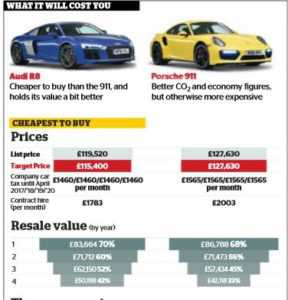 What are they like to drive? These cars don’t so much accelerate as detonate. Both have seven-speed, twin-clutch automatic gearboxes and clever launch control systems. When tested in the rain, it was the R8 that fl ung itself off the line fastest. It hit 60mph in 3.2sec, whereas the 911 lost time squirming away from the line, and only managed the sprint in 3.5sec. Wider experience tells us that in dry conditions it would be a different story, though, and there’s no doubting the joys of the 911’s savage 532bhp engine. It is able to deliver a hammer-blow of acceleration, although it isn’t too highly strung to be driven smoothly around town or on your favourite country road. However, the R8 still has the better engine. Its naturally aspirated 533bhp V10 revs to 8500rpm (the 911’s stops at 6800rpm), giving the car a frenetic race-car like feel; it’s packed with character and hugely addictive.
What are they like to drive? These cars don’t so much accelerate as detonate. Both have seven-speed, twin-clutch automatic gearboxes and clever launch control systems. When tested in the rain, it was the R8 that fl ung itself off the line fastest. It hit 60mph in 3.2sec, whereas the 911 lost time squirming away from the line, and only managed the sprint in 3.5sec. Wider experience tells us that in dry conditions it would be a different story, though, and there’s no doubting the joys of the 911’s savage 532bhp engine. It is able to deliver a hammer-blow of acceleration, although it isn’t too highly strung to be driven smoothly around town or on your favourite country road. However, the R8 still has the better engine. Its naturally aspirated 533bhp V10 revs to 8500rpm (the 911’s stops at 6800rpm), giving the car a frenetic race-car like feel; it’s packed with character and hugely addictive.
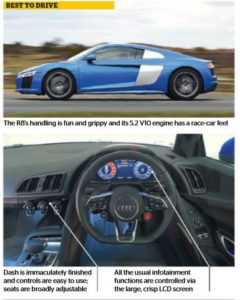 Predictably, the mid-engined R8 turns in to bends more sharply than the rear-engined 911. In fact, the R8 has more grip in general; it feels almost magnetised to the road, sticking rigidly to a neutral line even through high-speed direction changes. Some might even wish for a little more playfulness – a bit more slip at the rear wheels to give that sense that the car is giving you full control when you want a true, purist driving experience. In this respect, the 911 has the more exciting handling. Sure, its front wheels wash wide earlier than the R8’s through fast corners, but you can lightly tap the accelerator to help point the nose of the car where you want it to go. The experience is never too intimidating, and the 911’s heavier, more confidence-inspiring steering also impresses when you’re driving quickly. The R8’s lighter steering delivers an easy fluidity and more feedback at normal road speeds, however, which makes it the more enjoyable and rewarding car to drive much of the time. The R8 also has better body control, although its flat cornering doesn’t come at the cost of comfort. Our test car rode on standard ‘passive’ dampers (there’s an adaptive system on the options list), which soften the majority of bumps surprisingly well and keep the car settled most of the time. The 911 is fitted with adaptive dampers as standard, but it always leans fractionally more through fast corners and its ride is firmer, particularly at low speeds; it’s here that you’ll wish its suspension had a softer setting. Exhaust note is just as critical for cars that are bought for their feel-good factor, and it’s the R8 that sounds best. The V10 delivers a symphonic, crescendoing war cry (aided on our car by its £1800 sports exhaust), which tempts you to go out of your way to find tunnels and high walls to amplify the sound. Menacing as the 911’s bassy resonance is, it never manages to sound quite as thrilling. Surprisingly, it’s also the R8 that’s quieter when you’re cruising, mainly because its tyres kick up less road noise, although the 911 does have the smoother gearshifts in slow or mid-pace driving. What are they like inside? Tall drivers will fi t fi ne in either car, and fi nding a comfortable driving position is easy in both, too, thanks to supportive, fully electric seats. The truly lanky will appreciate the 911’s more generous head and leg room, but its seats are also a bit narrow around the shoulders, so they are less likely to suit those with a broader body. Both cars have beautifully fi nished interiors, with swathes of leather and metal and well damped buttons and switches that speak of expensive parts and attention to detail. Some sports cars in this price bracket feel surprisingly low-rent inside, but these two most defi nitely aren’t among them. The R8’s infotainment functions are displayed on a Virtual Cockpit, which is effectively a big LCD screen that sits behind the steering wheel where you’d normally fi nd the instrument dials. The screen can be set to focus more on the speedo, sat-nav map or stereo system. Everything can be controlled either by using an intuitive rotary dial that’s positioned between the front seats or buttons on the steering wheel. It takes a bit of practice, but once you’ve got used to having all this information right in front of you, and being able to control it without taking your hands off the wheel, you do really appreciate it. Other plus points are that the R8’s air-con is simple to use and its dashboard is logically designed. The 911 is more conventional inside, with its 7.0in colour touchscreen positioned in the centre of the dashboard. The screen responds quickly to presses, although the menus are harder to fathom and some of the smaller icons are tricky to hit precisely, especially when you’re driving. The 911 wins convincingly for practicality, though. Its two small rear seats are best used as luggage space, but they will accommodate small children for short trips, and they are better than the tiny shelf you get in the R8. Both cars have small but deep front-mounted luggage areas that’ll take a couple of soft weekend bags, but not much else.
Predictably, the mid-engined R8 turns in to bends more sharply than the rear-engined 911. In fact, the R8 has more grip in general; it feels almost magnetised to the road, sticking rigidly to a neutral line even through high-speed direction changes. Some might even wish for a little more playfulness – a bit more slip at the rear wheels to give that sense that the car is giving you full control when you want a true, purist driving experience. In this respect, the 911 has the more exciting handling. Sure, its front wheels wash wide earlier than the R8’s through fast corners, but you can lightly tap the accelerator to help point the nose of the car where you want it to go. The experience is never too intimidating, and the 911’s heavier, more confidence-inspiring steering also impresses when you’re driving quickly. The R8’s lighter steering delivers an easy fluidity and more feedback at normal road speeds, however, which makes it the more enjoyable and rewarding car to drive much of the time. The R8 also has better body control, although its flat cornering doesn’t come at the cost of comfort. Our test car rode on standard ‘passive’ dampers (there’s an adaptive system on the options list), which soften the majority of bumps surprisingly well and keep the car settled most of the time. The 911 is fitted with adaptive dampers as standard, but it always leans fractionally more through fast corners and its ride is firmer, particularly at low speeds; it’s here that you’ll wish its suspension had a softer setting. Exhaust note is just as critical for cars that are bought for their feel-good factor, and it’s the R8 that sounds best. The V10 delivers a symphonic, crescendoing war cry (aided on our car by its £1800 sports exhaust), which tempts you to go out of your way to find tunnels and high walls to amplify the sound. Menacing as the 911’s bassy resonance is, it never manages to sound quite as thrilling. Surprisingly, it’s also the R8 that’s quieter when you’re cruising, mainly because its tyres kick up less road noise, although the 911 does have the smoother gearshifts in slow or mid-pace driving. What are they like inside? Tall drivers will fi t fi ne in either car, and fi nding a comfortable driving position is easy in both, too, thanks to supportive, fully electric seats. The truly lanky will appreciate the 911’s more generous head and leg room, but its seats are also a bit narrow around the shoulders, so they are less likely to suit those with a broader body. Both cars have beautifully fi nished interiors, with swathes of leather and metal and well damped buttons and switches that speak of expensive parts and attention to detail. Some sports cars in this price bracket feel surprisingly low-rent inside, but these two most defi nitely aren’t among them. The R8’s infotainment functions are displayed on a Virtual Cockpit, which is effectively a big LCD screen that sits behind the steering wheel where you’d normally fi nd the instrument dials. The screen can be set to focus more on the speedo, sat-nav map or stereo system. Everything can be controlled either by using an intuitive rotary dial that’s positioned between the front seats or buttons on the steering wheel. It takes a bit of practice, but once you’ve got used to having all this information right in front of you, and being able to control it without taking your hands off the wheel, you do really appreciate it. Other plus points are that the R8’s air-con is simple to use and its dashboard is logically designed. The 911 is more conventional inside, with its 7.0in colour touchscreen positioned in the centre of the dashboard. The screen responds quickly to presses, although the menus are harder to fathom and some of the smaller icons are tricky to hit precisely, especially when you’re driving. The 911 wins convincingly for practicality, though. Its two small rear seats are best used as luggage space, but they will accommodate small children for short trips, and they are better than the tiny shelf you get in the R8. Both cars have small but deep front-mounted luggage areas that’ll take a couple of soft weekend bags, but not much else.
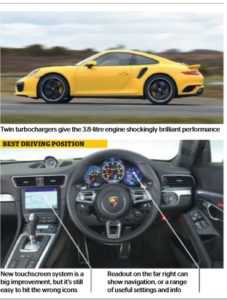
What will they cost? In spite of their hugely expensive list prices, the R8 is more than £12,000 cheaper than the 911 after you’ve haggled a few thousand off its already lower list price (you won’t get anything off the 911). The 911 is also marginally more expensive to buy on fi nance. Put down £20,000 on a three-year, 30,000-mile PCP contract, and it’ll cost £1672 per month compared with the £1659 Audi will charge. Servicing is also cheaper on the R8, with our experts estimating that tyres and maintenance over three years will cost almost £1000 less than the 911. If insurance or fuel costs are likely to be a concern, you may want to rethink the sort of car you’re shopping for. Electrically adjustable, heated leather seats, auto lights and wipers, LED headlights, sat-nav, a DAB radio, Bluetooth, climate control and rear parking sensors are all included on both. You even get a choice of metallic paint colours thrown in for free. Most buyers will want to add the £650 Driver Assistance Pack to the R8, which brings cruise control and a reversing camera (both included on the 911), and that £1800 sports exhaust is a must. Neither of these cars has been crash tested by Euro NCAP, but six airbags and an alarm and immobiliser are fi tted to both. You also get driving tuition on track included with both models.

*OUR VERDICT
These cars exist to make the driver feel special, and it’s the R8 that really stands out. Its engine is a masterpiece of free-revving, raucous power that makes you constantly crave another road to rage down. Of course, the 911’s heroic mid-range muscle and more playful high-speed handling are breathtaking, but the R8 thrills more at normal speeds and is hardly short of kicks when driven hard. Simply put, the R8 feels closer to being a supercar. It’s just a bit more special, and that’s what matters here.
